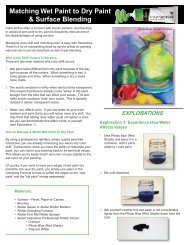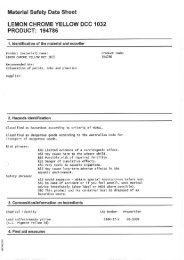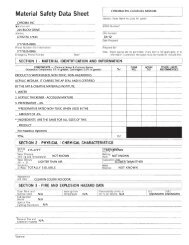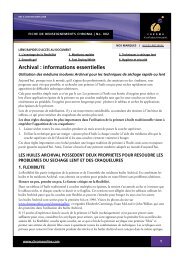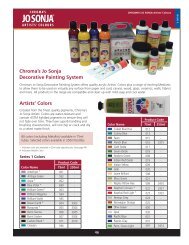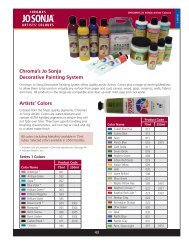How Atelier Interactive Works - Chroma
How Atelier Interactive Works - Chroma
How Atelier Interactive Works - Chroma
Create successful ePaper yourself
Turn your PDF publications into a flip-book with our unique Google optimized e-Paper software.
updated aug 2012<br />
CHROMA INFORMATION SHEET | No. 106<br />
<strong>How</strong> atelier <strong>Interactive</strong> <strong>Works</strong><br />
Featured Brands | <strong>Atelier</strong> interActive<br />
<strong>Atelier</strong> <strong>Interactive</strong> used to be known as just plain <strong>Atelier</strong>. It was a standard acrylic with a luscious smooth<br />
buttery consistency, lightfast colours and a very high pigment load. Today it still has these characteristics but<br />
now it’s also the most versatile acrylic paint on the market. This information sheet will explain in simple terms<br />
how the unique and patented (US Patent No: US 7,851,545 B2) <strong>Atelier</strong> <strong>Interactive</strong> formula works.<br />
notes on standard acrylIcs<br />
Acrylics can be made into a myriad of different things from aircraft windows to bath tubs, dental fillings and of<br />
course paints. The acrylic for paints is made by first turning it into an emulsion which is suspended in water at a<br />
ratio of about 45% using special copolymers designed to yield soft pliable paint films.<br />
To make paint you add this acrylic suspended in water mixture with other components such as pigments,<br />
preservatives, Ph additives, surfactants, thickener, dispersants etc - this is the simplified recipe for modern<br />
acrylic paints.<br />
The standard acrylics cure when all the water has evaporated and all the acrylic that was suspended starts to link<br />
together forming a matrix of the remaining components into a solid paint film.<br />
atelIer InteractIve explanatIon<br />
<strong>Atelier</strong> <strong>Interactive</strong> is made from similar components but with a unique (and patented US Patent No: US<br />
7,851,545 B2) difference - a chemical called an alkali soluble polymer, dissolved with water and amine, that<br />
coats the acrylic particles and slows down the adhesion of the particles to each other.<br />
The process begins as soon as the paint becomes touch dry and as the amine evaporates the bonds become<br />
stronger and the paint more waterproof.<br />
The acrylic particles are not bonded together until the amine has evaporated, so water can be added back into<br />
the paint layer when it becomes tacky and it will rewet allowing the artist to work for long periods wet in wet.<br />
<strong>Atelier</strong> <strong>Interactive</strong> becomes touch dry at the same rate as standard acrylics and can be overpainted before it is<br />
cured. Caution - see notes on use of mediums for Fast, Delayed or Slow techniques in the <strong>Atelier</strong> <strong>Interactive</strong><br />
Basic Users Guide 101.<br />
Adding any of the “traditional” fast mediums to the paint will make <strong>Atelier</strong> <strong>Interactive</strong> resilient and quick<br />
drying. Binder Medium, Fast Medium/Fixer and Impasto Gel are popular “traditional” mediums. (see the<br />
end of document for complete list). These mediums make <strong>Atelier</strong> <strong>Interactive</strong> feel and perform like a standard<br />
acrylic. Please note that once you use these products, the paint can’t be reopened because the bonding of the<br />
acrylic particles has taken place.<br />
www.chromaonline.com 1
CHROMA INFORMATION SHEET | No. 106<br />
tHe pluses and mInuses oF a tougH paInt<br />
Standard acrylics dry by forming a tough plastic skin, providing a real benefit for those artists who like to<br />
progress their painting quickly. The downside is that this skin formation only offers around 10-20 minutes<br />
to blend and work wet in wet. Standard acrylics force artists to work wet over dry, where edge feathering and<br />
blending becomes more difficult. The only option to achieving longer blending times is to use a retarder which<br />
can create an unstable sticky paint that takes too long to dry. Once the paint is finally dry you cannot decide to<br />
make any changes because it will not rewet.<br />
It is still very easy to do fast layering techniques like glazing and scumbling with <strong>Atelier</strong> <strong>Interactive</strong>, either<br />
through the use of traditional mediums or just by using a soft brush and waiting a little longer for the<br />
paint to firm up. Using <strong>Atelier</strong> <strong>Interactive</strong> you can quickly progress your painting.<br />
<strong>Atelier</strong> <strong>Interactive</strong>’s versatility gives it a clear advantage over standard acrylics and once understood you<br />
may never wish to go back to your old acrylics again.<br />
atelIer InteractIve Is not a sloW dryIng paInt<br />
The well known slow drying acrylic paints and mediums on the market are all based on glycol retarders that<br />
act to slow the evaporation rate of water. This means that the paint actually stays wet for an extended period<br />
of time. That is very different from how <strong>Atelier</strong> <strong>Interactive</strong> works; it dries at about the same rate as standard<br />
acrylics with the extra blending time only being achieved if the artist chooses to use a water sprayer or damp<br />
brush to rewet the painting.<br />
Slow drying glycol based paints and mediums don’t have the great versatility of <strong>Atelier</strong> <strong>Interactive</strong> because they<br />
dry far too slowly for standard acrylic techniques and can only be used for slow wet in wet blending. They are<br />
much slower and less convenient to use because when you have finished each stage of a painting you need to<br />
wait a long time to overpaint or varnish, more like an oil than acrylic. <strong>Atelier</strong> <strong>Interactive</strong> “Slow Method” also<br />
takes a long time to dry. See the <strong>Atelier</strong> <strong>Interactive</strong> Basic Users Guide 101 to select the best approach for your<br />
way of working.<br />
HoW unlockIng Formula <strong>Works</strong><br />
Unlocking Formula is a mix of isopropyl alcohol and water and it can be used to re-wet <strong>Atelier</strong> <strong>Interactive</strong> for a<br />
few days after it has cured - even after all the amine has evaporated. Once the alcohol has evaporated the acrylic<br />
particles re-bond into a strong paint film - using Unlocking Formula does not damage the painting or reduce<br />
the archival qualities of the paint.<br />
Over time the acrylic becomes less and less sensitive to alcohol so after a few days Unlocking Formula becomes<br />
much less effective. <strong>Atelier</strong> <strong>Interactive</strong> paintings that are varnished with the <strong>Chroma</strong> removable solvent varnishes<br />
can be safely stripped back with mineral spirits or turpentine because by the time restoration work is done the<br />
acrylic polymer will have become insensitive to alcohol and solvents. Very rough and continuous scrubbing is<br />
required to damage a fully cured <strong>Atelier</strong> <strong>Interactive</strong> painting.<br />
Unlocking Formula will not work if “traditional” fast drying mediums like Binder Medium or Impasto Gel have<br />
been mixed with the paint because they contain a standard acrylic binder which is insensitive to alcohol.<br />
HoW atelIer InteractIve <strong>Works</strong> WItH standard acrylIcs<br />
<strong>Atelier</strong> <strong>Interactive</strong> is 100% compatible with all other artists’ acrylics. It does not cause any problems when it is<br />
mixed with a standard acrylic binder, in fact a lot of <strong>Atelier</strong> Mediums contain a standard acrylic binder and they<br />
of course are compatible with <strong>Atelier</strong> <strong>Interactive</strong>.<br />
When <strong>Atelier</strong> <strong>Interactive</strong> is mixed with a standard acrylic binder, be it in the form of a medium or another<br />
brand of paint, it will dry fast with a waterproof skin - to do the “Delayed” or “Slow” blending techniques with<br />
<strong>Atelier</strong> <strong>Interactive</strong> you have to use only “<strong>Interactive</strong>” colours and “<strong>Interactive</strong>” mediums like Slow Medium.<br />
www.chromaonline.com 2
CHROMA INFORMATION SHEET | No. 106<br />
If you want to try <strong>Atelier</strong> <strong>Interactive</strong> for the first time you can mix it with your standard acrylic paints and it<br />
will perform just like any other high quality artists’ acrylic. A good idea is to use <strong>Atelier</strong> <strong>Interactive</strong> mixed with<br />
your old standard acrylics in the early layers of your painting and then finish off your artwork by switching<br />
exclusively to <strong>Interactive</strong> colours so that you can take advantage of the longer working time to feather edges, get<br />
your blends just right and make all of those important final adjustments.<br />
atelIer InteractIve and varnIsHIng<br />
It is recommended that you let your <strong>Atelier</strong> <strong>Interactive</strong> painting dry for a week before applying any water-based<br />
or solvent based varnishes. If slow drying mediums or retarder are used then you should wait longer. As an<br />
extra precaution a layer of Fast Medium/Fixer can be applied prior to varnishing as an isolating layer. When<br />
varnishing an <strong>Atelier</strong> <strong>Interactive</strong> painting, we recommend you always use a water-based <strong>Atelier</strong> Varnish or a<br />
<strong>Chroma</strong> Solvent Finishing Varnish.<br />
“tradItIonal” Fast dryIng medIums<br />
• NEW Gloss Medium<br />
• NEW Matte Medium (US Only)<br />
• NEW Satin Medium (US Only)<br />
• NEW Glazing Liquid<br />
• NEW Regular Gel (Gloss)<br />
• NEW Regular Gel (Matte) (US Only)<br />
• Heavy Gel (Gloss) (Previously Impasto Gel)<br />
• NEW Heavy Gel (Matte) (US Only)<br />
• Binder Medium<br />
• Fast Medium/Fixer<br />
• Moulding Paste (Previously Modelling Compound)<br />
• Matte Varnish (Previously Matte Medium & Varnish)<br />
• Satin Varnish (Previously Satin Medium & Varnish)<br />
• Gloss Varnish (Previously Gloss Medium & Varnish)<br />
For more information on using these mediums, please see <strong>Atelier</strong> <strong>Interactive</strong> Fast and Slow Painting Techniques<br />
Info sheet 102 and <strong>Atelier</strong> Guide to Grounds & Mediums. When these fast mediums are used, the advantage of<br />
reopening layers and colour matching between layers is lost. <strong>Atelier</strong> <strong>Interactive</strong> is compatible with conventional<br />
acrylics, but these mixtures revert to fast drying mode and are best used for under painting.<br />
For more InFormatIon, please reFer to<br />
• <strong>Atelier</strong> <strong>Interactive</strong> Basic Users Guide 101<br />
• <strong>Atelier</strong> <strong>Interactive</strong> Fast and Slow Painting Techniques Info sheet 102<br />
• Plein Air Painting with <strong>Atelier</strong> <strong>Interactive</strong> Info Sheet 103<br />
• Tips For Using Mediums with <strong>Atelier</strong> <strong>Interactive</strong> Info Sheet 104<br />
• <strong>How</strong> <strong>Atelier</strong> <strong>Interactive</strong> Dries Info Sheet 107<br />
• <strong>Atelier</strong> Guide to Grounds & Mediums.<br />
• <strong>Atelier</strong> <strong>Interactive</strong> Q & A Flier<br />
• <strong>Atelier</strong> <strong>Interactive</strong> Colour Chart<br />
• <strong>Atelier</strong> <strong>Interactive</strong> Website: www.atelierinteractive.com<br />
www.chromaonline.com 3



